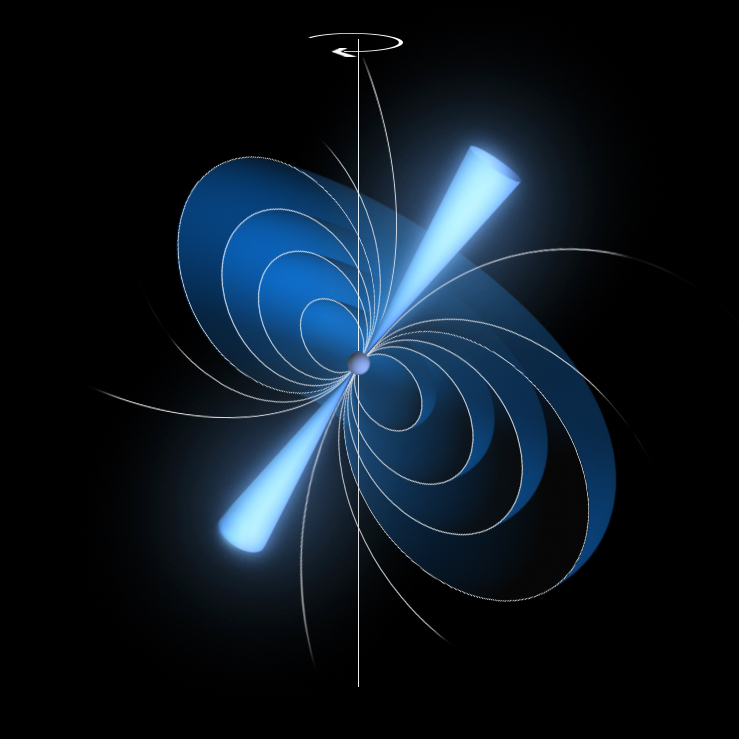
Pulsars are small stars on the order of 20 km in size – the size of a small town – with a rapid rotation ; their mass is comparable to that of the Sun. The ultra-dense body emits a extremely narrow beam of radiation. As a consequence of its rotation, the beam crosses the Earth periodically, giving rise to momentary increases of brightness, not unlike the effect of a light beam from a lighthouse. Some pulsars emit radiation covering the entire electromagnetic spectrum, from gamma rays, X-rays up to radio waves. And even though pulsars were discovered over 40 years ago, the details of just how they radiate are still poorly understood.
However, we have known for some time that some radio pulsars oscillate between two states, leading to changes in the shape and intensity of the radio pulses. The transition from one state to another is both sudden and unpredictable (occurirng often during a single rotation). Observations made from space have shown that a handful of radio pulsars are detectable also in X-rays. Nevertheless, nothing was known till now about the variability of the X-ray emission.
The scientists have have been studying a particular pulsar called PSR B0943+10, one of the first to be discovered. Il is 3 500 light years away, in the constellation of the Lion. The pulses of PSR B0943+10 change every few hours and the changes happen in roughly a second. Since the source also radiates weakly in X-rays, the team observed the pulsar using the ESA XMM-Newton X-ray telescope. Radiotelescopes were used at the same time for complementary low frequency observations. Although the Low Frequency Array LOFAR, installed in five European countries, including France at the Nançay (Cher) radioastronomy station of the Observatoire de Paris, was still under construction, it was able to furnish some usefull support.
The results were totally unexpected. Changes in the X-ray emission are synchronized with the radio emission, as one would have expected, but when the radio signal is strong and well structured, the X-ray signal is weak. Inversely, when the radio emission is weak the X-ray signal strengthens. And, remarkably, the transition takes just a few seconds, after which the pulsar remains stable in its new state for many hours. Current theories cannot explain such important and unpredictable changes. Possibly a rapid change of the entire magnetosphere is involved. This quite unexpected chameleon-like behaviour of the pulsar PSR B0943+10 will, 45 years after the discovery of neutron stars, revitalise fundamental research into the physical processes which take place in the extreme conditions of these environments.

(ESA medialab / XMM-Newton / ASTRON-LOFAR)
Note(s)
– French scientists involved in this study work at Université d’Orléans1 , CNRS, Observatoire de la Côte d’Azur, Observatoire de Lyon and Observatoire de Paris2.
– Low Frequency Array LOFAR is a large (30-240 MHz) antennae network 10 to 100 times more efficient and sensitive than any existing previous instrument. Intensive operating phase is just starting : 247 scientists from 17 countries have submitted observations requests. 38 projects have been selected at the end. About two dozens of French researchers are involved.
Reference
The present scientific result appears in the 25 january 2013 Science journal (Synchronous X-ray and Radio Mode Switches : a Rapid Transformation of the Pulsar Magnetosphere).
Contacts
– Jean-Mathias Griessmeier
CNRS/Université d’Orléans
OSUC région Centre
+33 (0) 2 38 25 76 56
1 The Laboratoire de physique et chimie de l’environnement et de l’Espace LPC2E is a joint laboratory operated by CNRS and Université d’Orléans.
2 The Laboratoire d’Études Spatiales et d’Instrumentation en Astrophysique LESIA is a science departement of Observatoire de Paris. It works in close partnership with CNRS, Université Pierre et Marie Curie, and Université Paris Diderot.
